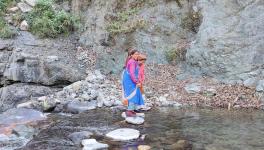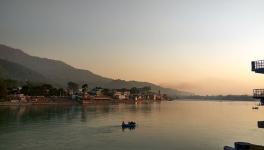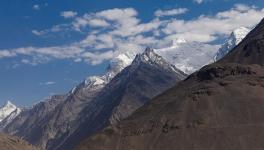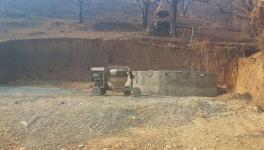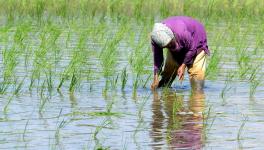The Char Dham Road Project is a Freeway to Disaster: CP Rajendran
File Photo.
Dr CP Rajendran is among India’s foremost experts on seismo-tectonics, earthquakes and tsunami geology. He is also a strong critic of the development model being pursued in Uttarakhand, a hilly state where the intensity of large-scale infrastructure projects has been rising along with the risks this poses to the fragile ecosystem, the latest being the cracks and land slide in Joshimath. Rajendran, who is also an adjunct professor at the National Institute of Advanced Studies, Bengaluru, is fearlessly vocal about the ills of such constructions, especially the large number of tunnels—66 to be exact—and dams that are being built across the small hilly state. He speaks to senior journalist Rashme Sehgal. Edited excerpts.
RS: You were critical of the government’s Char Dham project, which is under construction at a relentless pace. In the next 10 years, the government also plans to build 66 tunnels in Uttarakhand, which already has 18 tunnels in operation. What is the problem with these projects?
CPR: I have always thought the Char Dham road project is a freeway to disaster. As feared, it is indeed turning out to be an unscientific road construction project with catastrophic consequences for the mountain ecology. There are important environmental caveats to be respected before engaging in a mammoth engineering project in the Himalayas. The authorities, in their enthusiasm for “smoother” and “faster” “all-weather” connectivity for pilgrim tourists from the plains and the armed forces, ignored the government’s own recommended best practice norms to minimise the impact on the mountain ecosystems and landscapes. These engineering interventions are being done with scant regard to the local geology and environment. The construction of highways and railway tracks has now become a prime cause of landslides, whose occurrences have doubled over the years.
RS: Many tunnels are being built as part of a rail project that will criss-cross the Himalayas. Half the work on the Rishikesh-Karnprayag rail project is complete. Tunnels will account for 70% of this project. What kind of environmental impact does this imply?
CPR: Out of the 125 km track, the train will travel 105 km through tunnels. The longest tunnel will be 14 km long, from Devprayag to Janasu. Unlike many mountain chains in the world, the Himalayas are the youngest and most active in terms of tectonics. There is a belief that building tunnels may decrease the infrastructural impact on the environment. In fact, these subsurface structures could result in gross damage to the environment, including the concentration of pollutants from traffic exhausts compounded by a micro-environment with no sunlight and limited dispersion in long-distance tunnels.
Rail traffic may rely on electric locomotion, but constantly generated vibrations during train movements is another issue related to tunnels that will keep the mountain slopes eternally unstable and thus make them vulnerable to slide at the slightest trigger. Blasting to make these tunnels would often lead to weakening rock formations, further leading to landslides, besides generating huge quantities of excavated rock waste. The irreversible impact on groundwater, such as descending water levels, has also been observed in tunnel construction areas.
RS: And the world’s longest 30-km road tunnel is also being constructed between Dehradun and Tehri despite scientists warning on the increase in landslides from large-scale construction works.
CPR: Landslides do not occur in isolation. Depending on the nature of rocks, their competency, and the blasting methods employed, road and dam constructions act as contributing triggering mechanisms. The geology of the rocks and the nature of fissility within them (their tendency to split along planes of weakness) are important criteria to be considered. Many times, a slip occurs along such fractures.
Increased anthropogenic activities like road construction have made hill slopes extremely unstable. That is why recurring landslides have increased in numbers in the Himalayas, to which heavy downpours and cloud bursts due to climatic changes have also contributed. Excavating a tunnel induces stress changes, and consequent deformation within rock formations could also contribute to landslide vulnerability.
RS: Homes have developed cracks in villages around flattened mountain slopes and where massive excavation work is being done to construct tunnels. The list of peoples’ complainants is growing. What does this indicate?
CPR: Residents constantly complain about damage to their homes and the drying up of water sources. Such massive construction procedures will impact villagers and the livelihood of people there. Blasting during construction has resulted in cracks in houses and other buildings.
Equally alarming is vanishing spring water and other community water sources. For instance, a People’s Science Institute report says, “Their natural water sources, gharats, irrigation canals have all dried up, so much so that the village does not even have enough water to immerse cremated remains. Adding to their woes, cracks have started appearing on the walls of homes and other buildings...”
Erratic rainfall and ecological degradation associated with land use change for infrastructure development are already impacting mountain aquifer systems. In August 2018, a NITI Aayog report spoke of “increasing evidence that springs are drying up or their discharge is reducing throughout the Indian Himalayan Ranges and, indeed, throughout the entire Hindu Kush Himalayan region”.
Groundwater use in the Himalayan states differs from that in the plains, as large and contiguous aquifers do not exist in the hills. Villagers tap into small pockets, called perched aquifers, where water percolates into the soil, depending on the orientation of the rocks. Sometimes, these small aquifers overflow as springs, but there is enough evidence to show these are drying up.
Tunnelling may cause impediments to groundwater if it heads in a direction perpendicular to the tunnel axis. It can adversely affect the structures and can also influence the local ecosystem by hampering vegetation.
Despite claims of a successful tourism policy, the social conscience confronts many issues concerning the mountain population. Most of the local population continues to live in abject poverty, and the innumerable dams across the Himalayan rivers provide no relief to the people—read women—who must trudge miles looking for water from natural springs, which are also drying up fast.
RS: In strategically important Joshimath town, not only have many houses developed cracks, the town itself is sinking. Residents recently met the Uttarakhand State Disaster Management Secretary and told him they believed the Tapovan Vishnugad hydroelectric project tunnel and a bypass—part of the rail project—are responsible for their crisis. Is that right?
CPR: The residents allege that cracks have been developing in their houses since last year, but they did not get a proper response from the district administration. The geoscientists who visited Joshimath have recorded that several areas in that town in the Chamoli district, located at an altitude of 6,150 feet, are sinking rapidly due to human-induced causes. An expert team constituted by the Uttarakhand Disaster Management Authority certified in its 2022 report that “Joshimath town located on the thick cover of landslide material has been witnessing gradual sinking for a long time… Further uphill from the Joshimath-Auli Road, cavities and ground fissures were found.”
The Tapovan Vishnugad hydro project tunnel that passes just below Joshimath could be a contributing factor, among others. During the tunnel construction, it was reported that the boring machine had perforated a water-bearing stratum on the left bank of the Alaknanda River near Shelong village.
RS: In June 2022, the Chamoli district magistrate ordered the construction of a one-and-a-half-kilometre wall along the Alaknanda river to stop soil erosion. Will this help, or is it a cosmetic solution?
CPR: While implementing a freeway project in the Himalayas, a major question that stares you down is whether the mountain morphology with steep slopes and sharp gradients is easily amenable to human engineering. All these “hard approaches”, like building a retaining wall, will not work in such a dynamic environment in the long term. Upslope erosion or the river scouring during the flood seasons will eventually degrade such walls. The bank stabilisation must be done primarily by planting the appropriate species of trees. The rivers need their space to flow, and we must respect their relationship with their floodplains.
RS: With 100 dams under construction in Uttarakhand, scientists have warned of disturbances to the isostatic equilibrium, thereby increasing the possibility of earthquakes in the mountains.
CPR: It is reported from many sites that the gravitational load created by the large reservoir disturbs the isostatic equilibrium of the earth’s crust. The crust converts the received potential energy of hydrostatic pressure into the kinetic energy of vertical displacement that lasts for many decades, which are generally reservoir-generated earthquakes. The entire central Himalayas are currently locked, and the accumulated stresses due to Indian plate collisions are waiting to be released in earthquakes.
RS: Apart from Joshimath, Bhatwari and Uttarkashi are also sinking. Why would this be happening?
CPR: What we see in Joshimath and towns like Uttarkashi is a warning of what is in store for us in future. Experts believe the resilience of the Himalayan ecosystem is likely to overshoot. It is thanks to the unprecedented combination of climate change and its consequences, like flooding, droughts and wildfires, alongside other global change drivers (such as changes in land use, pollution, fragmentation of natural systems and over-exploitation of resources).
The melting of Himalayan glaciers is also likely to impact local rivers, either in the form of massive seasonal flooding or forcing them to dry up. We must remember that the Himalayan environment is on the brink of collapse. It may not be able to withstand another push generated by intrusive anthropogenic activities in the form of massive construction projects like highways, railway tracks and dams. Nor are there any serious attempts for compensatory afforestation.
RS: Why does the government not pay attention to scientific objections and conduct technically sound environmental impact assessments led by independent experts?
CPR: I fail to understand why the concerns expressed by many experts have been ignored. Economic interests play a major role. This is clear from the fact that there is a mad rush to award hydroelectric projects to private companies. Why?
Infrastructural development is one thing, but we also need to understand the fragility of the landscape we are interfering with. A realistic development strategy should be based on a blueprint that strikes a balance between infrastructure development, acceptable levels of risk, and the carrying capacity of the terrain. The average daily footfall last year in these areas was around 58,000. Ground reports say plastic waste has been dumped in large or small pits, and the cleaning operations resort to open burning, which is highly hazardous.
The Char Dham routes also witnessed a growing mound of garbage since the beginning of the pilgrimage season. Unregulated human activity during pilgrimages is most likely to impact water and air quality in these regions. Imagine the millions of travellers visiting the hills as part of the Char Dham pilgrimage circuit using the upcoming rail and road travel facilities and how this will pollute the mountain environment. Many hydroelectric projects need to be reviewed from the perspective of their long-term adverse impact.
The 2013 Kedarnath flood was a wake-up call. The intensity of this disaster was directly proportional to the unregulated rise in tourism that led to a construction boom in unsafe zones such as the river valleys, floodplains and slopes vulnerable to landslides, which violated land use laws. Any human-induced change beyond the carrying capacity of the Himalayas will impact stream run-offs and erosional and depositional processes. Considering such vulnerabilities, we need to keep the scale of human-induced disturbances to the minimum possible level. In its current form, the Char Dham project goes against all environmental safeguards.
RS: These projects cost lakhs of crores of rupees. Could these funds have been better utilised?
CPR: Many scholars like Sunita Narain have suggested how we should go about funding a development strategy for the Himalayas that does not come at the cost of the environment. This strategy should be based on the region’s natural resources like forests, water, biodiversity and ecotourism. Rather than building massive dams, our focus should be on small projects that would help provide a local energy supply. Agriculture in the Himalayan ranges is closely linked to animal husbandry and natural forests. Most farmers have now abandoned traditional practices and local seed varieties and wait for the State or private sector to supply them with the necessary inputs.
Reportedly, due to massive migrations from villages to the plains, less than 20% of agricultural land in the Himalayan districts of Uttarakhand is being farmed. The remaining 80% has become fallow land. It is one area that needs a massive influx of funds. An appropriate development strategy should also be able to use traditional knowledge of agriculture, construction practices, and local cultural aspects.
Rashme Sehgal is an independent journalist.
Get the latest reports & analysis with people's perspective on Protests, movements & deep analytical videos, discussions of the current affairs in your Telegram app. Subscribe to NewsClick's Telegram channel & get Real-Time updates on stories, as they get published on our website.











